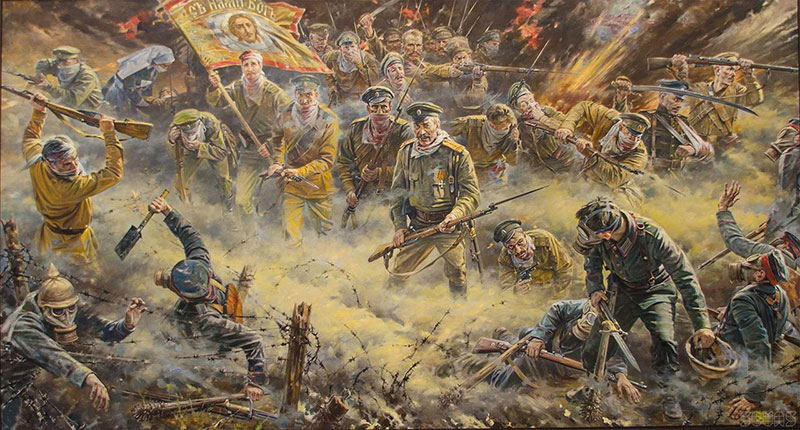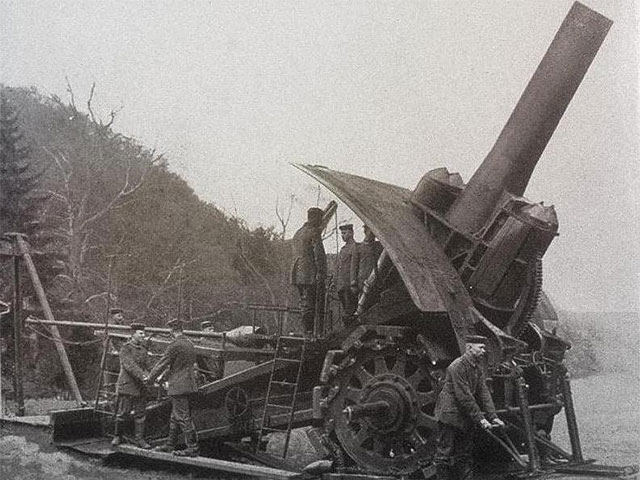
The catch phrase “The Russians never surrender!” spread all over the world as far back as the First World War. It originated at the time of defence of small Osovets fortress which is located nowadays on the territory of present-day Poland. The small Russian garrison was required to hold out only 48 hours. But they defended for more than half a year – 190 days!
Built by Russian military engineers at the end of the 19th century, 20km from East Prussia borders not great fortress “Osovets” deterred the assaults of two (the 5th and 6th ) German armies advancing in the direction of Grodno. The fortress blocked the way to Grodno and Belostock. The Germans could not bypass it.
In 1920 after concluding the Riga Peace Treaty Poland took control of Osovets settlement. The Poles decided to turn a destroyed fortress into an outpost against Germany. Clearing away the debris of the fortress they broke a hole. An officer and a soldier descended through the hole. They made only a pair of steps in total darkness when suddenly heard a clang of the rifle and menacing challenge: “Halt! Who goes there?” “Who are you? And what are you doing here?” – asked the officer fearfully. “I’m a sentry and I’m here to guard this warehouse” – replied a soldier. “And do you know what date is today?” “Of course, I do! I took the place nine years ago!” – answered Russian soldier.
In summer 1914 the Germans arrived in Osovets but they failed to capture the fortress at one fell swoop. And then a German officer under a white flag of truce appeared in the fortress and addressed himself to the Chief of Defence Staff Lieutenant Colonel Mikcail Svechnikov : “I can offer you 500 000 deutsche mark to yield up a fort …Trust me, it’s not a bribe or a payoff but a mere bargain. In assault we’ll spend ammunition to that amount. So we’d like to spare our ammunition. And YOU will stay alive! Otherwise, I vow, the fortress Osovets would cease to exist in 48 hours. And RUSSIAN OFFICER Mikcail Stepanovich Svechnikov answered to that politely: “I invite YOU to stay with us. If the fort does exist in 48 hours, I’ll swing you! If Osowets surrenders, please, could you be so kind and hang me! But I can’t take your money!”
The Germans employed all kinds of the most modern arms of those days against defenders of the fortress: four famous Big Berthas, which shells breached 2 meters wide steel and concrete walls. Craters were 5 metres deep and 15 metres in diameter. 64 another powerful siege weapons were also used and aviation as well.
On the 25th of February the Germans began to fire all weapons. They fired only 250000 heavy shells and 400000 in common. There were several thousand bombs and shells for each defender. They dropped them out of aeroplanes, fired from dozens of weapons of 17th battery including two well-known 450 mm “Big Berthas”. The last ones had just made havoc of Belgian fortress “Liege” but the Russians managed to put out of action them. The Germans bombed the fortress day and night, month after month. The Russians defended in the middle of the fierce fire and iron to the bitter end. They were extremely few, only one Zemlyansk regiment but there was the same respond with regard to proposal to surrender – “The Russian never surrender!” Then on 6th of August at 4 am the Germans deployed 30 gas batteries about 3000 gas cylinders against the fortress. A gas wave of chlorine and bromine from thousands of cylinders hit Russian lines of defence. This wave was 12 – 15 metres high, 8000 metres wide and travelled 20000 meters forward. The Russians did not have gas-masks.

All the living things were poisoned on the territory of the fortress. Grass was yellow and black. Thick acid-green layer of oxide chlorine covered metal sections of weapons and shells. At the same time the Germans started concentrated artillery bombardment. After that more than 7000 infantry men began advancing the Russian lines of defence.
The fortress seemed to be doomed and captured. Vast German hordes were approaching nearer and nearer…And at that very moment from acid-green chlorine smoke they were… counterattacked. The Russians were just over 60. That was left of 13th company of the 226th Zemlyansk regiment. There were more than a hundred enemies for each soldier!
The Russians were going in full growth, bayonets ahead. The soldiers looked awful: with faces mutilated by gas burns, wrapped with clothes around their bodies, shaking because of the terrible cough, coughing up through the clothes on their faces fragments of lungs on to bloody soldier’s blouses…
Those WARRIORS put the enemies in such a state of shock that the Germans rushed back without fighting. In panic they trampled down each other, confused and hung down over their own barbed wire fence. And at that time seemingly dead Russian artillery opened fire through the clouds of poisoned smoke.
That battle has gone down in history as “The attack of the dead men”. During that attack several dozen of half-dead Russian warriors succeeded in routing 14 enemy battalions!
Russian defenders of Osowets never surrendered the fortress. It was left later by order of command when defence lost sense. Neither a shell nor a nail was left for enemy. Everything that escaped destruction after German fire and bombing was blown up by Russian sappers. The Germans decided to occupy ruins only in several days…
The Russians didn’t surrender in the years of the Great Patriotic War as well. Brest Fortress, Adzhimushkay Quarry, Kiev football match with death, resistance movement in Western Europe, Pavlov’s House in Stalingrad, fascist dungeons…
The Russians did not just surrender; they won a victory over well-armed, trained and well-fed SS men even in block of death of the camp of death Mauthausen. Think over this phrase “block of death in the camp of death”! Its prisoners rebelled and conquered death with bare hands in fact.